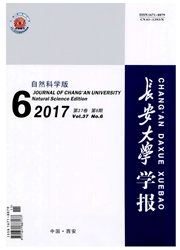

 中文摘要:
中文摘要:
为得到并道运行状态下车辆荷载对桥梁结构的作用效应,利用1座连续梁桥的实测车辆荷载数据,研究了并道运行状态下高速公路桥梁的车辆荷载效应分析方法。首先,根据车辆并道的特点,通过EM算法得到了车重、轴重、轴间距和车间距等参数的分布特征;然后,针对并道运行状态下车间距减小和拥堵的2种情况,提出了相应随机车辆荷载流的模拟方法;最后,结合随机车辆荷载影响线和极值分布理论,计算得到了并道运行状态桥梁车辆荷载效应的评估值,并分析了车间距对车辆荷载效应的影响规律。研究结果表明:并道运行状态下车重、轴重、轴间距服从混合Gauss分布,车间距服从对数正态分布;针对并道运行状态随机车辆荷载的模拟方法可以较好地分析该状态下高速公路桥梁的车辆荷载效应,其中车辆并道状态下所研究桥梁的荷载效应评估值分别为汽车超-20、公路Ⅰ级的1.13、1.03倍;当车辆并道且发生拥堵的最不利状态时,荷载效应分别为设计荷载汽车超-20、公路Ⅰ级的1.29、1.17倍;车辆并道受车间距的影响较大,车间距在2-5m时车辆间距内的效应值与车辆间距的大小基本呈线性关系,当车辆间距控制在10m以上时,可确保该桥实际车辆荷载效应小于设计荷载效应。研究结果可为并道运行状态桥梁承载能力评估和并道运行的交通布控提供参考。
 英文摘要:
英文摘要:
In order to obtain the effect of vehicle load on bridge structure in the state of lanes merging, vehicle load effect analysis method for expressway bridge was studied based on vehicle load data collected by WlM system on a continuous girder bridge. Firstly, according to the feature of lanes merging of vehicles, basic distribution characteristics of vehicle load including vehicle weight, axle load, axle spacing and vehicle spacing were obtained by using EM calculation method. Secondly, to solve two cases in the state of lanes merging, including decrease of vehicle spacing and vehicle jam the corresponding random vehicle load flow simulation method was presented. Finally, bridge load effect evaluation value in the state of lanes merging was obtained by combining stochastic vehicle influence line and extreme value distribution theory, and the influence of vehicle spacing on load effect was studied. The results show that the total vehicle weight, axle weight and axle spacing obey the mixed Gauss distribution, and the vehicle spacing obeys the logarithmic normal distribution. The present method can be well applied to analysis of the vehicle load effect in the state of lanes merging, and the load effect are about 1.13 and 1.03 times of the exceeded truck-20 and the highway grade I respectively. When is the lanes merging and vehicle jam happening in meantime, the corresponding vehicle load effect are 1.29 and 1.17 times of the exceeded truck-20 load effect and the highway grade I respectively. It is also found that effect of vehicle spacing linearly relates to the distance between two vehicles when vehicle spacing is between 2-5 m, and the actual vehicle load effect is definitely less than the design vehicle load effect when vehicle spacing is controlled at more than 10 m. The research results can provide references for the evaluation of bridge carrying capacity and the traffic control in the state of lanes merging. 5 tabs, 10 figs, 20 refs.
 同期刊论文项目
同期刊论文项目
 同项目期刊论文
同项目期刊论文
 Damage identification method of girder bridges based on finite element model updating and modal stra
Damage identification method of girder bridges based on finite element model updating and modal stra A Multi-scale Finite Element Model Validation Method of Composite Cable-stayed Bridge Based on Proba
A Multi-scale Finite Element Model Validation Method of Composite Cable-stayed Bridge Based on Proba Collapse Failure ofPrestressed Concrete Continuous Rigid-frame Bridge Model Under StrongEarthquake E
Collapse Failure ofPrestressed Concrete Continuous Rigid-frame Bridge Model Under StrongEarthquake E Finite Element Model Validation of the Bridge Based on Structural Health Monitoring ——Part I: Respon
Finite Element Model Validation of the Bridge Based on Structural Health Monitoring ——Part I: Respon Finite Element Model Validation of the Bridge Based on Structural Health Monitoring ——Part II: Uncer
Finite Element Model Validation of the Bridge Based on Structural Health Monitoring ——Part II: Uncer Seismic response study on a multi-span cable-stayed bridge scale model under multi-support excitatio
Seismic response study on a multi-span cable-stayed bridge scale model under multi-support excitatio 期刊信息
期刊信息
